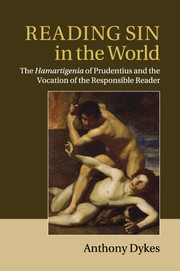Book contents
- Frontmatter
- Contents
- Acknowledgements
- Abbreviations, manuals and works of reference
- Bible texts used
- Classical texts used
- Electronic resources
- The names of biblical characters
- Vocabulary and style
- 1 Introduction: ‘Prudentius counts’
- 2 The world projects human responsibility
- 3 The vocation of the responsible reader: the biblical strategy
- 4 The vocation of the responsible reader: the genre strategy
- 5 Conclusion
- Appendix A A note on the title of the Hamartigenia
- Appendix B A brief note on the date and circulation of the Vulgate Genesis
- Bibliography
- Index
3 - The vocation of the responsible reader: the biblical strategy
Published online by Cambridge University Press: 03 May 2011
- Frontmatter
- Contents
- Acknowledgements
- Abbreviations, manuals and works of reference
- Bible texts used
- Classical texts used
- Electronic resources
- The names of biblical characters
- Vocabulary and style
- 1 Introduction: ‘Prudentius counts’
- 2 The world projects human responsibility
- 3 The vocation of the responsible reader: the biblical strategy
- 4 The vocation of the responsible reader: the genre strategy
- 5 Conclusion
- Appendix A A note on the title of the Hamartigenia
- Appendix B A brief note on the date and circulation of the Vulgate Genesis
- Bibliography
- Index
Summary
SEEKING STABILITY
Will the Hamartigenia merely create a confused, rather than a fruitfully disorientated reader? At the end of Chapter 2 we saw the variety of intertextual frames available for a literate and responsible reader who examines Prudentius's treatment of the episode of the flight from Sodom. The questions which still confront us are ‘Will there be any fixed point from which to view the poem?’, ‘Will this fixed point, if it exists, be in the Hamartigenia or in some text outside it?’ and ‘Can the responsible reader find any way out of the confusing multiplicity which the poem presents?’
At the end of Chapter 2 we saw also that sexual sin ‘humanizes’ the landscape, albeit in a perverse manner: this ‘humanization’ does not make the world gentler and more amenable, but rather reshapes inanimate creation to put on show the effects of human choice. The configuration of the world reflects fallen human nature and the impact of sins subsequent to the Fall. The world comes to mirror human depravity. In the panel of the flight from Sodom and in the panel of the ‘Fratres’ at the ‘biuium’ we saw the way in which characters in the poem themselves become part of the landscape. The Frater Pastoralis is swallowed up by the caenosae paludes; Loth's wife becomes a permanently present feature of the plain. Both characters ‘become’ landscape, but they are not defined or reconfigured by it. The landscape is reconfigured by them.
- Type
- Chapter
- Information
- Reading Sin in the WorldThe Hamartigenia of Prudentius and the Vocation of the Responsible Reader, pp. 102 - 173Publisher: Cambridge University PressPrint publication year: 2011

